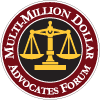Hit-from-Behind Tractor-Trailer Accident Shuts Down Highway
Two people were transported to Crozer-Chester Medical Center Trauma Unit recently when they smashed into a tractor-trailer in the breakdown lane on Interstate 476 northbound. The accident shut down the highway for more than four hours between MacDade Boulevard and Baltimore Pike.
Several EMS and fire companies responded to the incident and were there to cut the roof off of the Honda sedan to remove the driver and passenger. The process took more than 30 minutes.
Pennsylvania Turnpike Commission and the state police issued a press release regarding the incident calling the days before and after Thanksgiving “the busiest travel holiday of the year.” Last year there were more than two dozen fatalities on Pennsylvania highways between Thanksgiving and January 2, 2021.
According to PennDOT Acting Executive Deputy Secretary Melissa Batula, “Working together, we can all do our part to prevent crashes and fatalities on Pennsylvania roadways. We want everyone to arrive safely this holiday travel season, so please designate a sober driver and always wear your seat belt.”
This includes educating truckers regarding their responsibilities when on the highway, especially when they are on the shoulder or breakdown lane.
Many people assume that rear-end accidents are always the fault of the vehicle operator behind the impacted car. This isn’t always the case when it comes to rear-end crashes that involve tractor-trailers.
Truck operators must follow certain regulatory obligations to warn other drivers of a disabled tractor-trailer.
According to the Code of Federal Regulations 392.22, truckers on the shoulder, break down lane, or in a lane of travel must turn on their hazard flash lights immediately and keep them on at least until they’ve placed the triangle warning devices. Triangles must be placed within 10 minutes of the breakdown.
Triangles must be placed:
- One on the traffic side of and 4 paces (approximately 3 meters or 10 feet) from the stopped commercial vehicle in the direction of approaching traffic
- One at 40 paces (approximately 30 meters or 100 feet) from the stopped commercial vehicle in the center of the traffic lane or shoulder occupied by the commercial motor vehicle and in the direction of approaching traffic
- One at 40 paces (approximately 30 meters or 100 feet) from the stopped commercial motor vehicle in the center of the traffic lane or shoulder occupied by the commercial motor vehicle and in the direction away from approaching traffic.
Additionally:
- If you’re stopped on a hill, curve, or near a visual obstruction within 500 feet of a curve, crest of a hill, or other obstruction to view, the driver shall place the warning signal in the direction of the obstruction to view a distance of 100 feet to 500 feet from the stopped commercial motor vehicle so as to afford ample warning to other users of the highway.
- If you’re stopped on a divided or one-way road, the driver shall place the warning devices, one warning device at a distance of 200 feet and one warning device at a distance of 100 feet in a direction toward approaching traffic in the center of the lane or shoulder occupied by the commercial motor vehicle. He/she shall place one warning device at the traffic side of the commercial motor vehicle within 10 feet of the rear of the commercial motor vehicle.
- If you become stopped in a business district or residential area warning devices are not required within the business or residential district of a municipality, except during the time lighted lamps are required and when street or highway lighting is insufficient to make a commercial motor vehicle clearly discernable at a distance of 500 feet to persons on the highway.
At Heavens Law, we’ve worked with people injured in tractor trailer accidents of all kinds. Even if you were driving the vehicle that collided with the truck from behind, you could be eligible for compensation if the tractor-trailer driver did not follow protocol.
For more information or to discuss your situation, contact Heavens Law at 484-467-8254. All phone consultations are free and confidential, with no obligation beyond that.






